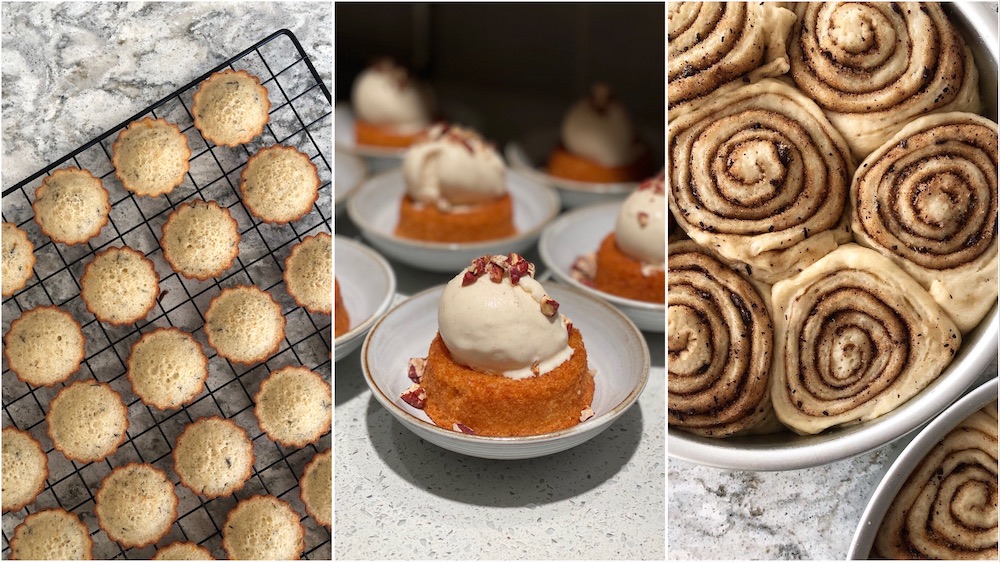In recent years, Asian-inspired flavors like matcha, red bean, ube and black sesame have grown in popularity and ubiquity. Additionally, Korean misugaru benefits the flavor and nutritional value of anything from shakes to pastries as it is naturally rich in vitamins and adds a deliciously nutty spice.
There is another Asian ingredient, though, with comparably distinctive and delicious taste, health benefits, and potential for wide application in the food world. Often overlooked, it sits in your local H-Mart (and on Amazon) with an earthy, nutty flavor that feels familiar somehow but not exactly like anything you’ve had before.
Ever heard of Korean misugaru? This mixed, multigrain powder is made with various grains that have been roasted or steamed and finely ground. The exact ratios of the different grains may vary, but can include rice (white, black, brown or sweet), millet, barley, adlay, soy beans, barley, quinoa, oats, black beans, sesame seeds, corn and more. Some brands boast 17-20 grains in their misugaru.
Though this list of grains can initially bring to mind flavors like chalky oatmeal or bland protein powder, one taste may just change your mind: Ahnesty describes misugaru as having a “cereal, malty, nutty flavor,” and I couldn’t say it better. There are both subtly sweet and savory notes and a well-rounded nuttiness and depth to it.
You may have encountered the misugaru latte at Caffe Benne and other Korean coffee shops — that’s because the main application for misugaru powder has traditionally been in beverage form, mixed with water or milk and a bit of honey or sugar. It can be made into either a hot or cold drink, but many Koreans have fond memories of growing up drinking cold misugaru shakes after school or during the sweltering summer months; ice required. Despite its popularity, is misugaru healthy? Yes! Because of its protein content, fiber, calcium, and vitamins and minerals, misugaru is also regarded as a healthy – and still tasty – option.
Misugaru can be found in Korean grocery stores in instant packets (which you can mix directly into water or milk for a ready-made drink) and bags of pure powder. As the pre-portioned instant packets have some added sweetener, Ahnesty advises that this might be an approachable way to give misugaru a try without committing to it fully ... yet. Some Korean rice cake stores and bakeries can even grind grains that customers bring into “custom” misugaru for them.
Though Korean misugaru has primarily been consumed in drinks (or at the most sprinkled over shaved ice desserts or ice cream), I’ve been determined to creatively utilize this ingredient in my baking. As a pastry cook, I’m passionate about thoughtfully incorporating Korean flavors into my dishes and baked goods, so exploring misugaru’s potential has been exciting and educational.

With its nutty flavor profile, misugaru can take center stage with all its malty goodness, be a supporting player to bolder flavors, or act as a pop of color on a blank canvas. For a pop-up supper club that I launched a few months ago, I made individual milk and honey spelt cakes filled with coffee whipped cream and topped with misugaru ice cream, toasted pecans and a sprinkle of Maldon salt. The subtle savory notes of misugaru played well with the milky and sweet flavors, and my friend commented that the dessert brought her right back to her childhood when her mom would make her misugaru shakes after swim practice. I love that food can vividly conjure up meaningful memories, and facilitating this kind of special “time travel” is a huge privilege.
I’ve also used misugaru as I would a spice, adding it to a glaze for brownies and a cream cheese icing for sourdough “cinnamon” buns. I actually replaced the usual cinnamon in the buns with a hearty dose of misugaru; the predominant flavor was still brown sugar, but misugaru accentuated it in a unique earthy way. Cream puffs with misugaru pastry cream were another off-roading adventure as of late. I’ve even utilized the sweetened instant misugaru packets in citrus and thyme financiers that I made for a Baker’s Box menu item.
As I’ve worked with misugaru, I’ve found that there is a lot of wiggle room for experimentation. The flavor is pronounced yet not overpowering, so you can add as little or as much as you want to a recipe. Sometimes I add a tablespoon to my pancake batter just because — it’s not obvious that it’s in there taste-wise, but it’s a fun and healthy addition to a routine breakfast item. Can you imagine misugaru’s potential as an ingredient in sugar cookies, a ganache filling or tres leches cake?
Korean misugaru benefits a beverage, but it definitely doesn’t need to stop there. As I continue to learn and grow my pastry skills and small business, I hope to find new and delicious ways to put this Korean pantry ingredient to use. In an attempt to broaden misugaru’s reach and appeal, my brother and I have started developing a misugaru spread (named “mishu butter”) that can be spread on toast, eaten with crackers or enjoyed as a dessert topping. Who knows, it could be the next peanut butter alternative! You can stay in the loop on product updates and a release date on our website.
Misugaru goes to show that there are culinary gems hidden in plain sight, ready to be explored and applied to the world of desserts. The results? Likely tasty and definitely surprising — in the best kind of way.
Gain the foundation and confidence to experiment with ingredients in ICE's Pastry & Baking Arts program.




